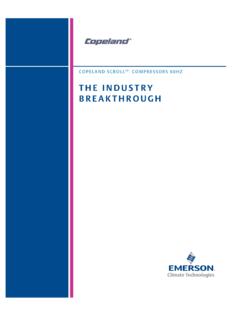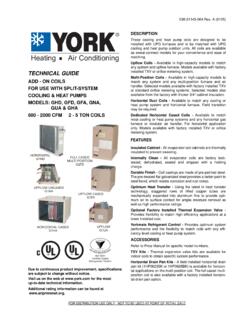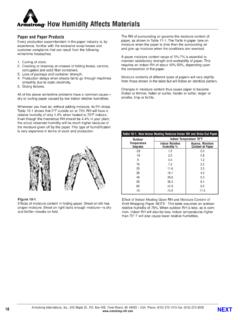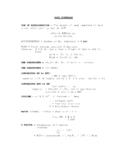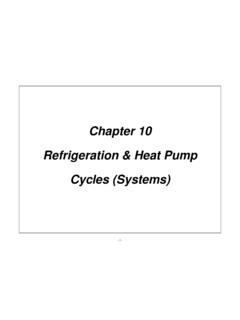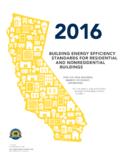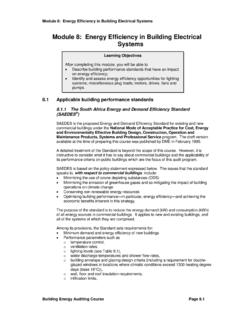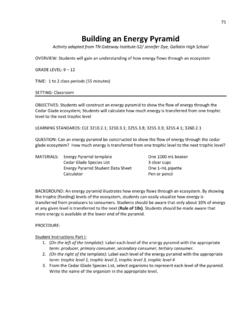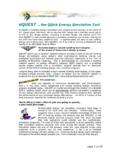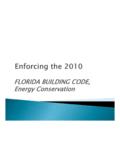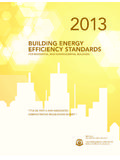Transcription of Energy Consumption Characteristics of …
1 Energy Consumption Characteristics of commercial building HVAC Systems Volume I: Chillers, Refrigerant Compressors, and Heating Systems Prepared by Detlef Westphalen And Scott Koszalinski Arthur D. Little, Inc. 20 Acorn Park Cambridge, MA 02140-2390. Arthur D. Little Reference No. 36922-00. For Office of building Equipment Office of building Technology State and Community Programs Department of Energy Project Manager: John Ryan (DOE). Contract No.: DE-AC01-96CE23798. April 2001. Disclaimer This report was prepared as an account of work sponsored by an agency of the United States Government. Neither the United States Government nor any agency thereof, nor any of their employees, nor any of their contractors, subcontractors, or their employees, makes any warranty, express or implied, or assumes any legal liability or responsibility for the accuracy, completeness, or usefulness of any information, apparatus, product, or process disclosed, or represents that its use would not infringe privately owned rights.
2 Reference herein to any specific commercial product, process, or service by trade name, trademark, manufacturer, or otherwise, does not necessarily constitute or imply its endorsement, recommendation, or favoring by the United States government or any agency, contractor or subcontractor thereof. The views and opinions of authors expressed herein do not necessarily state or reflect those of the United States Government or any agency thereof. Available to the public from: National Technical Information Service (NTIS). Department of Commerce 5285 Port Royal Road Springfield, VA 22161. 1-800-553-6847. NTIS Number: PB2001-104340. Office of building Technology Website ii Acknowledgements The authors would like to acknowledge the valuable support provided by others in the preparation of this report.
3 Dr. James Brodrick of the Department of Energy provided day-to-day oversight of this assignment, helping to shape the approach, execution, and documentation. He also reviewed and critiqued multiple draft versions of the report. Alan Swenson of the Energy Information Administration provided advice on approach to segmentation, provided critical information derived from the 1995 commercial Buildings Energy Consumption Survey, and reviewed the final report. Mr. John D. Ryan of the Department of Energy sponsored this assignment, and provided overall strategic guidance. Finally, the authors acknowledge the contributions and comments of the following individuals who provided review of the final report. Neil Rolph Weil McLain Robert Schmitt York International Corporation Wayne Reedy Carrier Corporation Joost Brasz Carrier Corporation Phil Ardis Tropic-Cool Engineering Corporation Joe Donahue Energy Planning, Inc.
4 Ian Shapiro Taitem Engineering Dave Bixby Gas Appliance Manufacturer's Association Erin Boedecker Energy Information Administration Joe Huang Lawrence Berkeley National Laboratory David Winiarski Pacific Northwest National Laboratory John Shugars Lawrence Berkeley Nation Laboratory i TABLE OF CONTENTS. 1 EXECUTIVE 1-1. Study Objectives ..1-1. Summary of 2 2-1. Background ..2-1. Study Approach and Report 3 DESCRIPTIONS OF SYSTEMS AND EQUIPMENT .. 3-1. Cooling System Types ..3-1. Central Systems ..3-1. Packaged Individual Room Air Heating System Types ..3-5. Further System and Equipment Description and 4 MARKET TRENDS .. 4-1. Refrigerant Trends ..4-1. Equipment Sales Cooling Equipment and System Design Trends ..4-4. Heating Equipment Design Trends.
5 4-8. 5 BASELINE Energy USE 5-1. building Stock Cooling Segmentation Methodology ..5-5. Heating Segmentation Methodology ..5-8. Equipment Energy Use ..5-10. building Thermal Extrapolation of Calculation Results ..5-11. Equipment Seasonal Results - Cooling ..5-13. Results - Heating ..5-17. Total HVAC Energy Use ..5-21. Comparison to Other Studies ..5-24. 6 CONCLUSIONS AND RECOMMENDATIONS .. 6-1. 7 7-1. APPENDIX 1: building SEGMENTATION ..A1-1. APPENDIX 2: BACKGROUND ii LIST OF FIGURES. FIGURE 1-1: PRIMARY Energy USE EQUIPMENT BREAKDOWN ..1-2. FIGURE 1-2: HVAC EQUIPMENT DISTRIBUTION ..1-3. FIGURE 1-3: PRIMARY Energy USE - building TYPE BREAKDOWN ..1-4. FIGURE 1-4: HEATED AND COOLED commercial building FLOORSPACE ..1-4. FIGURE 1-5: PRIMARY Energy USE -- REGIONAL BREAKDOWN.
6 1-5. FIGURE 1-6: commercial building FLOORSPACE REGIONAL BREAKDOWN ..1-5. FIGURE 1-7: TOTAL HVAC PRIMARY Energy FIGURE 3-1: SCHEMATIC OF A CENTRAL SYSTEM WITH A WATER-COOLED CHILLER ..3-2. FIGURE 3-2: SCHEMATIC OF A PACKAGED SYSTEM ..3-4. FIGURE 4-1: MONTREAL PROTOCOL HCFC PHASE-OUT TIMETABLE ..4-1. FIGURE 5-1: OVERVIEW OF Energy USE CALCULATION METHODOLOGY ..5-2. FIGURE 5-2: building STOCK SEGMENTATION (COOLING SYSTEMS)..5-5. FIGURE 5-3: EQUIPMENT TYPE DISTRIBUTION FOR COOLING ..5-7. FIGURE 5-4: ANNUAL EQUIPMENT LOAD EXTRAPOLATION DATA COMPARISON ..5-12. FIGURE 5-5: COOLING PRIMARY Energy USE-EQUIPMENT BREAKDOWN ..5-14. FIGURE 5-6: Energy USE COMPARISONS OF PACKAGED AND CENTRAL SYSTEMS. (NEW YORK CITY SMALL OFFICE building )..5-15.
7 FIGURE 5-7: COOLING PRIMARY Energy USE AND FLOORSPACE - building TYPE. BREAKDOWN ..5-16. FIGURE 5-8: COOLING SITE Energy USE INTENSITY BY building TYPE ..5-16. FIGURE 5-9: COOLING PRIMARY Energy USE - GEOGRAPHIC REGION FIGURE 5-10:HEATING PRIMARY Energy USE AND FLOOR SPACE - EQUIPMENT. BREAKDOWN ..5-18. FIGURE 5-11:HEATING PRIMARY Energy USE AND FLOORSPACE - building TYPE. BREAKDOWN ..5-19. FIGURE 5-12: HEATING SITE Energy USE INTENSITY BY building TYPE. (NON-ELECTRIC FUELS) ..5-19. FIGURE 5-13: HEATING SITE Energy USE INTENSITY (ELECTRICITY)..5-20. FIGURE 5-14: HEATING PRIMARY Energy USE - GEOGRAPHIC REGION BREAKDOWN ..5-20. FIGURE 5-15: TOTAL HVAC PRIMARY Energy USE BY building FIGURE 5-16: HVAC PRIMARY Energy USE INTENSITY BY building FIGURE 5-17: TOTAL HVAC PRIMARY Energy USE BY REGION.
8 5-23. FIGURE 5-18: TOTAL HVAC PRIMARY Energy USE INTENSITY BY FIGURE 5-19: COMPARISON OF THIS STUDY'S RESULTS TO OTHER STUDIES ..5-24. iii LIST OF TABLES. TABLE 3-1: EQUIPMENT TYPE SUMMARY ..3-6. TABLE 4-1: CURRENT AND FUTURE TABLE 4-2: ENVIRONMENTAL IMPACT AND PERFORMANCE OF REFRIGERANTS ..4-2. TABLE 5-1: SEGMENTATION VARIABLES OF REFERENCE 9 ..5-4. TABLE 5-2: SEGMENTATION REGIONS AND REPRESENTATIVE CITIES ..5-4. TABLE 5-3: WATER LOOP HEAT PUMPS ..5-8. TABLE 5-4: CHILLER TABLE 5-5: CORRELATION OF HEATING/COOLING EQUIPMENT CATEGORIES ..5-9. TABLE 5-6: CORRECTION FACTORS FOR DOUBLE TABLE 5-7: DISTRIBUTION OF FLOORSPACE BY HEATING FUEL ..5-10. TABLE 5-8: LOAD MAPPING FROM SYSTEM TO EQUIPMENT ..5-11. TABLE 5-9: EUI EXTRAPOLATION DATA COMPARISON CHOICES.
9 5-12. TABLE 5-10: EQUIPMENT SEASONAL EFFICIENCIES ..5-13. TABLE A1-1: FLOORSPACE SEGMENTATION - building TYPE AND SYSTEM TYPE (MILLION. SQFT).. A1-1. TABLE A1-2: FLOORSPACE SEGMENTATION: GEOGRAPHIC REGION (MILLION SQFT) ..A1-1. TABLE A1-3: COOLING EQUIPMENT SEGMENTATION BY building TYPE (MILLION SQFT)..A1-1. TABLE A1-4: HEATING EQUIPMENT SEGMENTATION BY building TYPE (MILLION SQFT)..A1-2. TABLE A2-1: HEATED/COOLED AND TOTAL A2-1. TABLE A2-2: COOLED FLOOR AREA (RAW DATA)..A2-2. TABLE A2-3: CBECS95 COOLING EQUIPMENT DATA .. A2-3. TABLE A2-4: UNITARY AC SHIPMENT DATA (1994) .. A2-4. iv 1 EXECUTIVE SUMMARY. This report is the first volume of a three-volume set of reports on Energy Consumption in commercial building HVAC systems in the This first volume focuses on Energy use for generation of heating and cooling, in equipment such as boilers and furnaces for `heating and chillers and packaged air-conditioning units for cooling.
10 The second volume, already in print, focused on parasitic Energy use or the Energy required to distribute heating and cooling within a building , reject to the environment the heat discharged by cooling systems, and move air for ventilation purposes. The third volume in the set will address opportunities for Energy savings in commercial building HVAC systems. As mentioned above, this study focuses on the equipment and equipment components used to generate heating and cooling. It does not include fans and pumps, which are the topic of the Volume 2 report. This distinction is clear for most equipment types, such as unit heaters, boilers, and chillers. However, for packaged air-conditioning (AC) equipment the distinction can be subtle.
